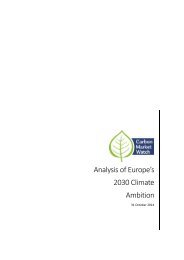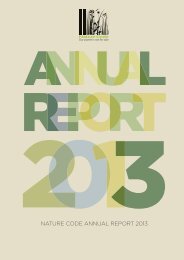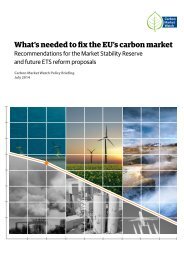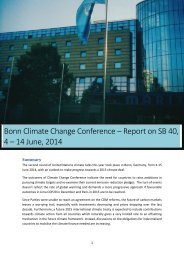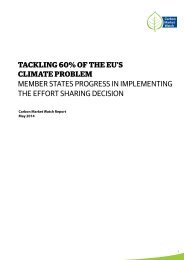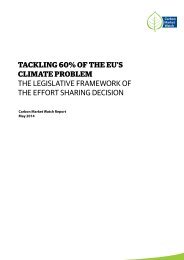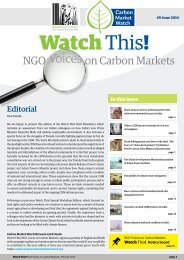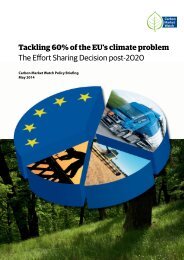THE ROLE OF INTERNATIONAL OFFSETS IN THE FUEL QUALITY DIRECTIVE
You also want an ePaper? Increase the reach of your titles
YUMPU automatically turns print PDFs into web optimized ePapers that Google loves.
JI has much fewer projects but has nevertheless been marred<br />
by a lack of transparency and a glut of credits with questionable<br />
environmental integrity. About one third of Kyoto offsets come<br />
from JI projects; 95% of those are from Track 1 projects. For projects<br />
that are implemented under JI Track 1, countries can approve<br />
projects and issue as many credits without international oversight.<br />
There has been an exponential growth in issuance of JI Track 1<br />
credits from Russia and Ukraine. This is troubling because ERUs are<br />
shadowed by AAUs (Assigned Amount Units; tradable emission<br />
permits under the Kyoto Protocol). Given that there are no more<br />
countries that are interested in trading AAUs, the option to convert<br />
AAU into ERUs gives countries with large AAU surplus (such as<br />
Russia and Ukraine) a way to keep using the surplus AAUs in the<br />
form of ERUs. This not only undermines environmental integrity<br />
but also threatens the viability of carbon markets. The table below<br />
shows the issuance of JI credits compared to the amount of AAU<br />
surplus owned by a country.<br />
5873<br />
6000<br />
CP1 AAU Surplus<br />
in milion tonnes of CO2e<br />
(right axis)<br />
5000<br />
4000<br />
2594<br />
3000<br />
2000<br />
500000<br />
447’850<br />
489<br />
752<br />
263<br />
669<br />
102<br />
318<br />
28 85<br />
205<br />
21 132 40<br />
1000<br />
0<br />
400000<br />
ERUs issued<br />
as of April 2013<br />
(left axis)<br />
300000<br />
226’813<br />
200000<br />
100000<br />
0<br />
11’634<br />
10’464 9’183 8’938 8’520<br />
2’600 1’908 1’340 1’321 972 607 523<br />
Ukraine<br />
Russsia<br />
Germany<br />
Poland<br />
France<br />
Romania<br />
Lithuania<br />
Bulgaria<br />
New<br />
Zeland<br />
Sweden<br />
Hungary<br />
Filand<br />
Czech<br />
Republic<br />
Estonia<br />
Almost a quarter (22,6%) of projects in the Joint implementation<br />
(JI) pipeline are fugitive type and account for almost half (45,4%)<br />
of issued ERUs annually –they are expected to deliver 138 million<br />
offset credits in total. All registered JI projects which pursue oil field<br />
flaring reduction have been registered in Russia. Of these, projects<br />
with crediting period starting from 2011 onwards are expected to<br />
deliver total emission reductions of more than 8 billion tonnes of<br />
CO 2<br />
equivalent, with annual reductions of more than 4.5Mt CO 2<br />
.<br />
Moreover, there are 32 natural gas transportation and distribution<br />
projects that stop gas leaks, most of them located in Ukraine and<br />
Russia which could also be an eligible project type.<br />
8




